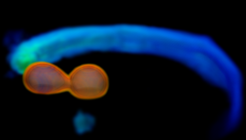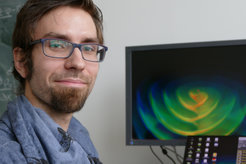Simulating neutron star mergers
German Physical Society awards thesis prize to Tim Dietrich
In his PhD thesis Dr. Dietrich investigated the gravitational wave signals of merging neutron stars. Gravitational waves from black holes have been detected directly in 2015 for the first time. Dietrich’s results increase our knowledge about neutron stars and help to interpret upcoming gravitational wave detections of neutron star mergers. Dietrich did his PhD at the Friedrich Schiller University in Jena from 2012 to 2015, and defended his thesis in 2016. Since the Fall of 2015 he is a postdoctoral scholar in the Astrophysical and Cosmological Relativity division at the Max Planck Institute for Gravitational Physics in Potsdam.
Neutron stars are extremely dense remnants of supernova explosions. Inside neutron stars more than two solar masses can be compressed in a diameter of only ten kilometers. In his PhD thesis Dietrich investigated inspiralling and merging binary neutron stars and the emitted gravitational waves during their coalescence. The strong gravitational fields present during the last milliseconds before and after the merger can only be described by Einstein's theory of general relativity. "The equations of general relativity and relativistic hydrodynamics for these neutron star collisions are so complex that close to the moment of merger no analytical solutions exist," says Dietrich. Therefore, the gravitational waves emitted during the merger are computed numerically on large computers.
However, numerical simulations and analytical models work hand in hand, since the search and analysis of gravitational waves require knowledge of an enormous number of different waveforms. Thus, many parameter combinations have to be considered: different mass ratios and spins and various models of neutron star matter. Dietrich showed for the first time how the neutron stars’ spins influence the gravitational wave signal.

Numerical relativity simulations provide realistic gravitational wave predictions, but the complex simulations are computationally too expensive and time consuming and cannot provide the large number of waveforms needed to infer astrophysical information upon detection. But Dietrich’s results helped to improve semi-analytical waveforms such as the ones based on the "Effective-One-Body” model, which allows to calculate hundred thousand of waveforms in a short time. Based on improvements of the semi-analytical solutions, it became for the first time possible to predict the waveform accurately up to the moment of the merger. This is a crucial prerequisite to understand and study neutron star matter.
In addition, Dietrich found universal relations between the composition of the neutron stars and the gravitational wave signal. "Building on the research results, we understand the physics of neutron stars better," Dietrich explains. "In fact, neutron stars are the only laboratory to test cold matter at densities higher than the density inside an atomic nucleus."
At the Max Planck Institute for Gravitational Physics, Dietrich has continued his research on neutron stars. He has improved numerical methods to obtain more accurate predictions of the expected gravitational wave signals and he is leading a large international project for a systematic analysis of the possible binary neutron star parameter space. This includes the examination of electromagnetic radiation. In contrast to binary black hole mergers, which can only be observed with gravitational waves, neutron star mergers are also visible with other astronomical methods.

Dr. Tim Dietrich (born 1988) studied physics at Martin Luther University Halle-Wittenberg where he received the Gustav-Mie-Bachelor-Award in 2010. In 2012, he graduated from the Friedrich Schiller University in Jena and did his PhD on simulations of neutron star mergers, defending his thesis in 2016. A large number of papers have emerged from his thesis. During his studies, Dietrich was funded by a scholarship of the German National Academic Foundation and by a state graduate scholarship from the Free State of Thuringia. Since 2015, he is a postdoctoral scholar in Prof. Buonanno’s Astrophysical and Cosmological Relativity division at the Max Planck Institute for Gravitational Physics in Potsdam. Recently, he received an individual Marie Curie Fellowship from the European Commission to continue his studies of binary neutron star systems.
German Physical Society’s Thesis Awards
The different divisions of the German Physical Society award annual prizes for the best PhD thesis. Dr. Tim Dietrich, together with Dr. Simon Spannagel (CERN), have been awarded with the prize of the divisions "Gravitation and Relativity", "Physics of Hadrons and Nuclei", and "Particle Physics". The prize-giving ceremony was held on the 29th of March 2017 at the University of Münster during the Spring Meeting of the German Physical Society.













